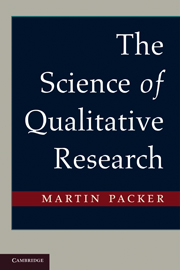Book contents
- Frontmatter
- Contents
- List of Figures and Tables
- List of Boxes
- Acknowledgments
- Introduction
- Part I The Objective Study Of Subjectivity
- 1 What Is Science?
- 2 The Qualitative Research Interview
- 3 The Analysis of Qualitative Interviews
- 4 Hermeneutics and the Project for a Human Science
- 5 Qualitative Analysis Reconsidered
- Part II Ethnographic Fieldwork – The Focus On Constitution
- Part III Inquiry With An Emancipatory Interest
- References
- Name Index
- Subject Index
4 - Hermeneutics and the Project for a Human Science
- Frontmatter
- Contents
- List of Figures and Tables
- List of Boxes
- Acknowledgments
- Introduction
- Part I The Objective Study Of Subjectivity
- 1 What Is Science?
- 2 The Qualitative Research Interview
- 3 The Analysis of Qualitative Interviews
- 4 Hermeneutics and the Project for a Human Science
- 5 Qualitative Analysis Reconsidered
- Part II Ethnographic Fieldwork – The Focus On Constitution
- Part III Inquiry With An Emancipatory Interest
- References
- Name Index
- Subject Index
Summary
The hallmark of the “linguistic revolution” of the twentieth century, from Saussure and Wittgenstein to contemporary literary theory, is the recognition that meaning is not simply something “expressed” or “reflected” in language: it is actually produced by it.
Eagleton, 1983, p. 60If we are to rethink the use of the interview as a tool in qualitative research, we must ask some fundamental questions. What does it mean to understand what someone says? What does it mean to understand a text? What is the “meaning” of a text? What is the relationship between a text and its author’s subjective experience? The coding approach to analysis assumes that the answers to these questions can be found in the conduit metaphor for language. This metaphor implies that words or short phrases “represent” objects and events, that experience is “put into” words, that to understand is to “unpack” this content from the form, and that this “meaning” can be repackaged in language that avoids indexicality. We have seen how unsatisfactory these answers are.
But these answers are not the only ones possible. These questions have been asked for hundreds of years, and a variety of answers have been proposed. For 200 years, they have been topics of scholarly debate in philosophy, literary theory, and religion, in the field known as hermeneutics. Ironically, research with qualitative materials today more closely resembles the way people thought about these matters in the 18th century than it does contemporary views. The objective study of subjectivity has much in common with what is known as “Romanticist” hermeneutics. Yet the Romanticist view of interpretation, although very influential in the 1700s and for a considerable period afterward, searched for something unreachable. It required an endless circle of interpretation, or empathic leaps of identification with an author, or the appeal to a metaphysical notion of a universal life-force unfolding toward an objective end point.
- Type
- Chapter
- Information
- The Science of Qualitative Research , pp. 82 - 98Publisher: Cambridge University PressPrint publication year: 2010



